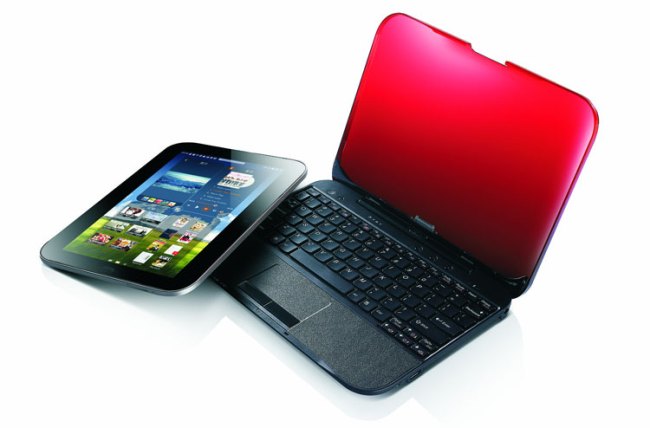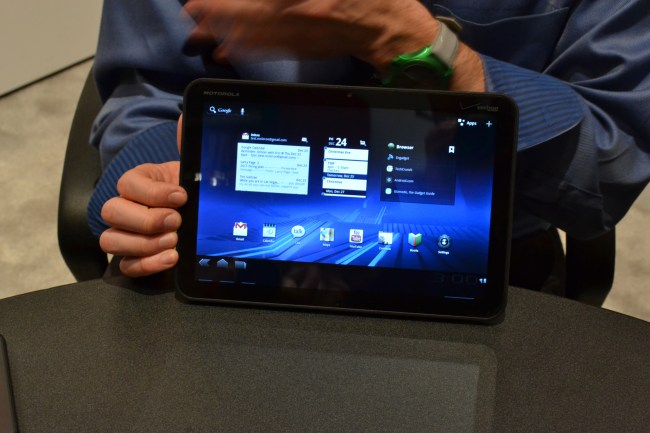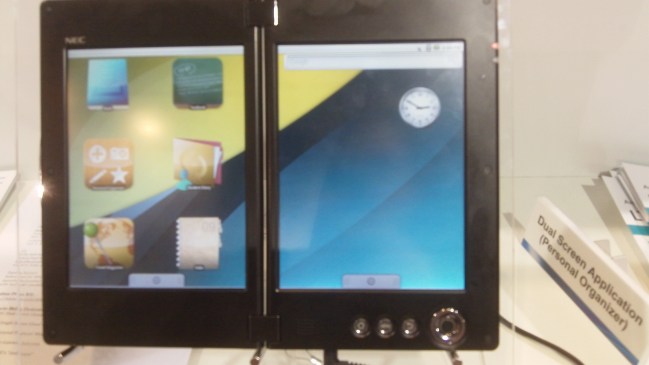 To say there were a few tablets at the 2011 Consumer Electronics Show would be a vast understatement. With more than 80 tablet launches in total, there were at least as many Android tablets and devices on the show floor as almost anything else, including 3D devices, which popped up almost everywhere else. There was even a 3D tablet, as a matter of fact.
To say there were a few tablets at the 2011 Consumer Electronics Show would be a vast understatement. With more than 80 tablet launches in total, there were at least as many Android tablets and devices on the show floor as almost anything else, including 3D devices, which popped up almost everywhere else. There was even a 3D tablet, as a matter of fact.
We’ve boiled down the overflowing list of tablets down to a manageable 25. There are dozens we missed, no helping that. This is not a technical guide to the tablet world, merely a recap of some of the notable (and some notably bad) tablets we saw at the show. Page one and two cover the big electronics manufacturers, while three and four dive deep into the bowels of CES to find the best and worst of the rest. Enjoy!
The Big Guys
Motorola Xoom

The Motorola Xoom is our favorite tablet of the show. With a 10.1-inch screen, hot new 1GHz Nvidia Tegra 2 dual-core processor, and running Google’s upcoming Android 3.0 (Honeycomb), the Xoom was the most complete package of any tablet on display. Motorola’s Droid provided the first good alternative to the iPhone last year, and the manufacturer may repeat history. The Xoom appears to have everything it takes to challenge the dominance of the iPad in the tablet space. It will be a Verizon exclusive at launch in the first quarter, and swappable modems will make it upgradeable to 4G later this year. Time will tell if the final device can match its CES presence. Click here to read our full impressions of the Xoom.
BlackBerry PlayBook
The BlackBerry PlayBook entered CES an underdog, but left as one of the hot items of the show. Like the Xoom, this tablet packs a dual-core processor and a full gigabyte of RAM, but it is no Android or BlackBerry device. Instead, RIM has chosen to size the PlayBook a leaner 7-inches, hoping to capitalize on a smaller tablet market not filled with the iPad. Though we weren’t terribly awed by the size (10 inches seems more practical), the new BlackBerry Tablet OS (powered by QNX) is pretty impressive. It feels reminiscent of Palm’s WebOS, but the PlayBook takes multitasking to a new level, allowing quick swipes between apps and simultaneous play of a number of apps at once. It’s Web browsing capabilities are also above par for a tablet. The PlayBook had no problem running numerous flash and video-filled Webpages, a tough task for most. Check out our full impressions here.
Toshiba Android Tablet

This still-unnamed Toshiba tablet is running Android 2.2, but should be upgradeable to 3.0 (Honeycomb) before the tablet hits retail sometime this spring. There isn’t much else notable about the device, though like the Xoom, it has an odd 16:10 aspect ratio. Unlike the Xoom, it still features the four Android 2.2 standard buttons on the bottom. It will ship with Toshiba’s BookPlace e-reader app, and the Toshiba Places app store built in. Interestingly, unlike many tablets, it will have a removable battery. Click here for more pictures.
Dell Streak 7 and 10

Dell’s 5-inch Streak failed to capture much interest when it hit AT&T last year, but the PC manufacturer isn’t done yet. At CES, it unveiled 7 and 10-inch models of the Streak. Both devices have three physical buttons on the bottom, and are 4G capable on T-Mobile. The Streaks currently run Android 2.2 on a 1GHz Nvidia Tegra 2 dual-core processor, and have 16GB of internal storage. The rear camera is 5MP, but the front-facing camera is a bit weaker than some of the higher-end tablets at only 1.3MP. It will come preloaded with some unique apps, including T-Mobile TV, BrainPOP, Zinio, Qik Video Chat, Blockbuster, Kindle, Slacker Radio, and Zoodles. Click here to learn more.
Dell Inspiron Duo

The Streak is Dell’s stab at a tablet, but you may be asking what the PC maker has up its sleeve to capitalize on the dozens of people who can’t decide whether they want to buy a tablet or netbook. The answer is the Dell Inspiron Duo. This fine little lappy has a rotating 10.1-inch screen, effectively morphing it from a small, netbook to a very fat touch tablet. And since it runs Windows 7, it won’t be a very good tablet either. Worse, its webcam appears to be embedded inside the PC frame, making it impossible to stare at your own face while touching your tablet.
Samsung 7 Series Sliding Windows PC
Sliding phones are so 2008, but sliding computers, now that’s a hot idea. Samsung’s 7 series is actually a 10.1-inch netbook-tablet hybrid running Windows 7. Unlike the Dell Inspiron Duo, this tabletdrawer computer has dual-facing cameras no matter which way it’s oriented. The screen slides up and then arcs up to get that classic laptop feel without the dastardly screen protection a clamshell design provides. All worth it: Samsung claims the 7 Series boots up in 20 seconds or less. Check out our impressions here.
The Big Guys (cont’d)
Lenovo LePad

Computer executives are seeing dollar signs in merging netbooks and tablets. The Lenovo LePad is another great example of this. Like a frog on a lily pad, the LePad is a tablet that can hop right off its pesky netbook shell and do all the things a good tablet is made for — watching movies, playing games, and consuming. Unlike the Samsung and Dell hybrids, the LePad runs both Windows 7 and Android. When docked, the device runs a on a 1.2GHz Intel Core i5 processor (upgradeable to i7). When undocked, the tablet runs a skinned version of Android 2.2 Lenovo is calling LeOS on a 1.3GHz Snapdragon processor. Pretty cool, right? Unfortunately, it’s going to be expensive and unavailable. Together, the docking computer and LePad will cost a hefty $1,300, and it won’t be available for a while. Lenovo plans to sell the LePad in China until Android 3.0 is ready to go. Even then, it’s rumored that 3.0 requires a dual-core processor so… it may be a while.
Lenovo IdeaPad Slate

The IdeaPad Slate looks a lot like the LePad except it runs Windows 7, meaning you’ll have more fun if you use a stylus. It runs on Intel’s Oak Trail processor and has a 10.1-inch widescreen, the preferred size for new tablets, it seems. It’s stylus control is pretty solid, but we weren’t able to check it out long enough to make any final judgement. The pen he’s using in this picture is battery powered. Click here to see more pictures of the IdeaPad Slate.
Asus Eee Pads and Eee Slate EP121

Never to be left behind on any possible trend, Asus showed off four different touch tablets and computers at CES. Starting from the left, the Eee Pad MeMo is a 7-inch tablet running Android 3.0 (Honeycomb). It has the same high-end IPS-style screen used in the iPad — all four of these devices do, actually. It also includes a stylus. The Eee Pad Transformer is a tablet that docks into a netbook keyboard, much like the LePad. It runs Nvidia’s Tegra 2 processor and is supposedly thinner than the iPad (barely). The other big feature: Asus claims the docking station will pump its battery life to 16 hours. Next, the Eee Pad Slider is pretty similar to Samsung’s 7 Series Slider. To prop up the screen, you pull out a picture frame-like kick-stand on the back of the unit. Still, it’s only 2/3 of an inch thick; not bad. Finally, the Eee Slate EP121 was one of the largest tablets at the show at 12.1 inches. Oddly, it runs Windows 7 and has more in common with a PC than a tablet. The back is pretty thick, complete with slits for venting, something you don’t see on many tablets. It’s stats are impressive though. It runs an Intel core i5, has 64GB of storage, and 4GB of RAM. To read more about the Eee Slate, click here. For more information about the rest of the tablets, click here.
Acer Iconia Tab A500

Here’s another 10.1-inch tablet running Android. On the show floor, the A500 ran Android 2.2, but reps assured that the final unit will run Honeycomb. Most notably, it has a Nvidia Tegra 2 dual-core processor in it and will run on Verizon’s 4G LTE network. This one has a full size USB port as well as a microUSB. Though it’s still on Android 2.2, there are no face buttons on the device, as Honeycomb no longer needs them. Overall, the Iconia A500 felt pretty nice, but didn’t wow us in any significant way.
Panasonic Viera Tablets

Panasonic did wow us, but it was more shock than excitement. We got very excited when we saw pictures of Panasonic’s 4, 7, and 10-inch touch tablets, but the excitement ended there. Though they are running Android, Panasonic’s tablets are little more than oversized, touchable remote controls for its pretty new Viera Connect TVs (Internet TV). Representatives told us these tablets could theoretically function as standalone tablets, but that Panasonic is choosing to limit them to living room use. The tablets run Android 2.2 with Panasonic’s Viera UI skinned on top. When we tested them, the tablets proved more frustrating than useful. They were unresponsive and laggy. We aren’t sure what Panasonic is trying to accomplish. Does it just want to add tablets to seem cool? Fair enough, we guess. Click here for more information on Panasonic’s tablets and fancy new $500,000 TV.
Sharp Galapagos Tablet

We went hands on with the Japanese versions of Sharp’s new tablets, and we were not impressed. Though they’re called the Galapagos (yes, they are), the devices are hardly fit to survive in a crowded tablet market. They’re thick, look chubby, and comes in two very strange sizes: 5.5 and 10.8-inches. The smaller unit seems to be designed to display paper-back books, but we found it hard to do much else with it, like read a magazine. Worse, both units run an odd version of Linux that lacks basic features like a Web browser and feels downright sluggish in comparison to most tablets at the show. Pages in an e-book took entire seconds to flip over after a swipe of the finger. Sharp has included its own e-book store, and the device does not currently include access to Barnes & Noble, Google, or Amazon e-book stores. Thankfully, Sharp may significantly rework the Galapagos tablets prior to bringing them stateside. Click here for our full impressions.
The Little Guys
The major U.S. electronics and PC makers all dipped their hands in the tablet game, but that didn’t stop everybody else from giving it a go too. Here are some of the coolest, and lamest, tablets from smaller vendors at CES.
NEC LT-W Cloud Communicator

The LT-W intends to be the Nintendo DS of the tablet world. It has two equally sized touch screens, both running an instance of Android 2.1. The screens are a bit washed out and low quality when compared to the best tablets at the show, but NEC showed off some unique ways to use the two screens (7 inches combined) together. The device is capable of running two apps on separate screens or one app stretched across both, enabling some neat multitasking. It was more a concept than a finished product, with demos on ways to use it as an e-book reader and notebook for students, but overall, it was lacking in design and responsiveness. It runs on the ARM Cortex processor. It will hit the Japanese market in mid 2011. Click here to read more about the LT-W.
Motion CL900 Windows Tablet

The tablet is meant for the construction manager in your life. It’s water and weather resistant, has a rubber coating to help with bumps and dings, a 10.1-inch widescreen LED display that is viewable outdoors, and a Gorilla Glass screen, which can take a beating. It runs on a 1.5GHz Intel Atom Oak Trail processor and has up to 60GB or internal storage and 1GB or 2GB of RAM. Motion tells us it chose Windows 7 for the device to ensure that it is fully compatible with all software businesses are already running. Fair enough. Still, we couldn’t help wonder how much more fluid the device would have run with a touch-based operating system like Android. Click here to read more.
iStation Zood 3D tablet

iStation combined the best of two hot ticket items at CES: tablets and 3D. The Zood is capable of full 3D using passive glasses (the kind you use at the movie theater). Though there isn’t a lot of 3D content out there to view, the Zood displayed it well for a tablet. If 3D is your thing, this Android 2.2 tablet has got it going on. It also looks pretty slick compared to a lot of the smaller vendor’s tablets.
Coby Kyros Internet Tablets

Coby had a whole line of Kyros Internet Tablets on display. While nothing is particularly horrid about any of them, they join a huge number of tablets at the show that just have nothing unique to say about themselves. They run basic versions of Android, and lack the cooperation with Google necessary to access things like the Android Market. In addition, most of the units felt like blown-up smartphones. The screen quality was a bit low, and the units lagged when pressed with multitasking. Four out of six of the 7-to-10.1-inch tablets featured resistive screens, meaning you have to actually press down on the screen to get a response. We weren’t big fans of these. As one representative told a group of people: “They can do all that stuff the kids like to do, like movies, games, and music.” A little out of touch?
Gadmei Android Tablets

Coby failed to impress, but Gadmei made us smile. Above is an example of one of the games on display. Gadmei had about six different tablets on display. They all appear to be Android based, but it’s hard to tell as movies or games were playing on most of the devices. This particular unit gets about 3 hours of battery life and has an 8-inch screen.
The Little Guys (cont’d)
Ace NomadPAD 10 series

Looks like an iPad, runs like an Android. iPad-like tablets littered the show floor. This 10.1-inch tablet has a 2MP camera, Tegra processor (1st generation), and has a Windows 7 twin. What separates it from the crowd? A tired representative told us that there is nothing unique about it, but that it isn’t about having a unique or best product. It’s about being on the market.
Archos 10 Internet Tablet

It looks nicer than most of the lower-end tablets we saw, but there’s still little to differentiate the Archos 10 other than its kickstand that holds it up at about 30 degrees for easier typing and viewing on a table. We can confirm that it runs Angry Birds quite well, if that is a selling point for you.
Rockchip Tablet RK29XX

The Rockchip booth was full of iPad clones. Many of the high-end models were said to be 3D capable, but the claim is a bit misleading, as they are merely capable of rendering 3D polygonal graphics, as seen in every console game since Super Mario 64.
SBNTech All in One Embedded IP Multimedia Communicator

Generic Android devices weren’t limited to tablets. This VOIP video calling device ran 2.2 and had a touch screen as well. You would think that SBNTech would create a custom interface to skin over Android to make its product easy to use for anyone, but no. We were pretty confused how to even initiate a video call, though the information sheet lists a ton of ways it’s compatible with such uses. The camera maxes out at VGA quality, so don’t expect to call Grandma in HD.
Jinys Tablets

Ah, a favorite booth of the show. Instead of just mimicking the iPad like most companies, Jinys came right out and claimed its new tablet was an iPad. It even had a big poster of its tablet with an iOS homescreen on it. Genius. The actual tablet did look like the iPad, but it felt more like a McDonald’s toy, full of painted silver plastic and an iPad home button.
The rest
There were more tablets on display than we can hope to discuss here. If you still haven’t gotten your fix, here are a few more tablets you can look up: the Aluratek Cinepad, AOC Breeze, Gentouch Latte (Latte Grande, Expresso), Notion Ink Adam, Azpen Windows 7/Android tablet, Vizio tablet, and the eFun Nextbook Next 4 and Next 6. If we missed anything exciting, let us know! CES is a big event.


